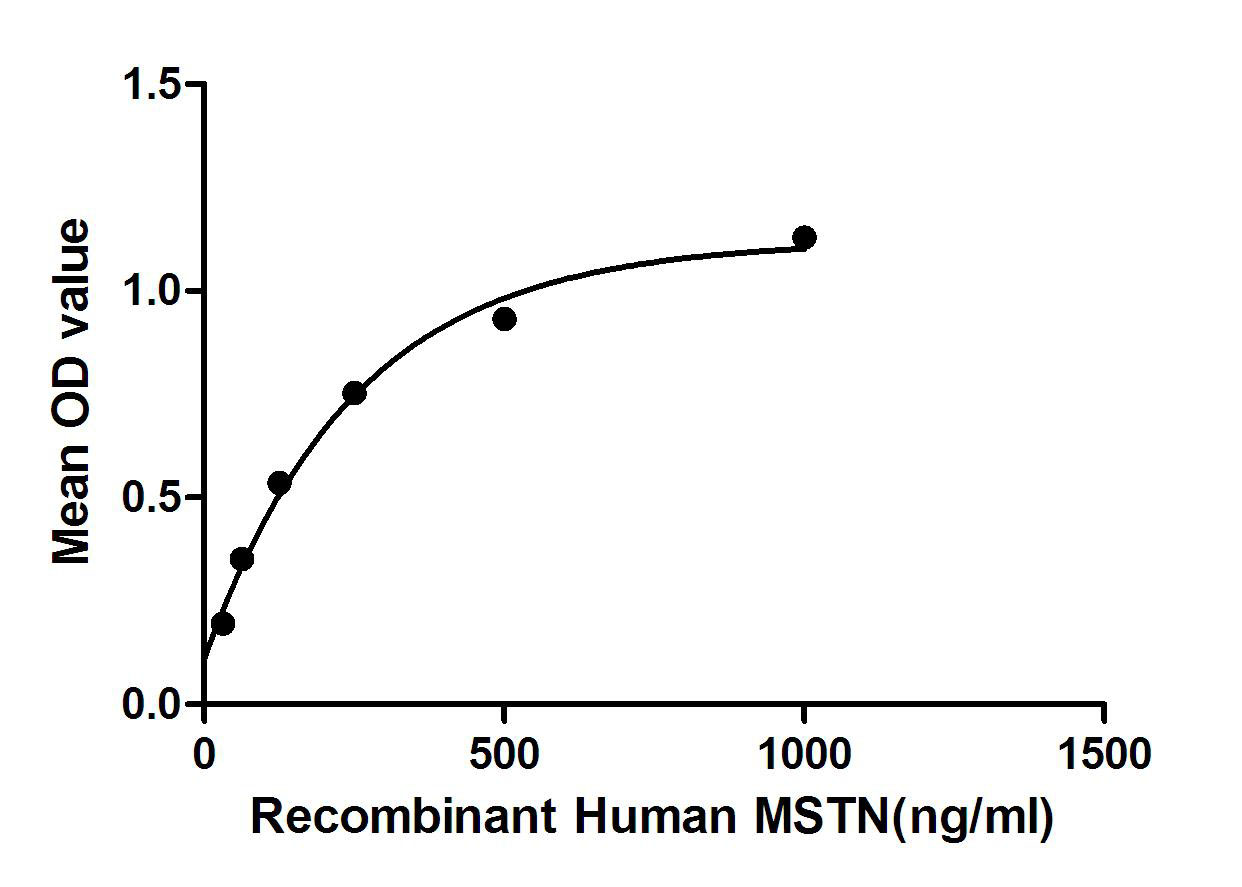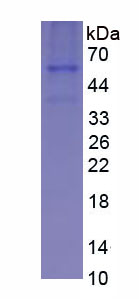Active Myostatin (MSTN) 

GDF8; Growth Differentiation Factor 8
- UOM
- FOB US$ 310.00 US$ 774.00 US$ 1,548.00 US$ 4,644.00 US$ 11,610.00
- Quantity
Overview
Properties
- Product No.APB653Hu61
- Organism SpeciesHomo sapiens (Human) Same name, Different species.
- ApplicationsCell culture; Activity Assays.
Research use only - DownloadInstruction Manual
- CategoryCytokineMetabolic pathwayBone metabolism
- Buffer Formulation20mM Tris, 150mM NaCl, pH8.0, containing 1mM EDTA, 1mM DTT, 0.01% SKL, 5% Trehalose and Proclin300.
- Traits Freeze-dried powder, Purity > 95%
- Isoelectric Point6.4
Sign into your account
Share a new citation as an author
Upload your experimental result
Review

Contact us
Please fill in the blank.
Activity test

Myostatin (MSTN) also known as growth differentiation factor 8 (GDF-8) is a member of the TGF beta protein family. Myostatin is a secreted growth differentiation factor that produced and released by myocytes. This protein negatively regulates skeletal muscle cell proliferation and differentiation. Besides, Bone Morphogenetic Protein 1 (BMP1) has been identified as an interactor of MSTN, thus a binding ELISA assay was conducted to detect the interaction of recombinant human MSTN and recombinant human BMP1. Briefly, MSTN were diluted serially in PBS, with 0.01% BSA (pH 7.4). Duplicate samples of 100uL were then transferred to BMP1-coated microtiter wells and incubated for 2h at 37℃. Wells were washed with PBST and incubated for 1h with anti-MSTN pAb, then aspirated and washed 3 times. After incubation with HRP labelled secondary antibody, wells were aspirated and washed 3 times. With the addition of substrate solution, wells were incubated 15-25 minutes at 37℃. Finally, add 50µL stop solution to the wells and read at 450nm immediately. The binding activity of MSTN and BMP1 was shown in Figure 1, and this effect was in a dose dependent manner.
Figure. The binding activity of MSTN with BMP1.
Usage
Reconstitute in 20mM Tris, 150mM NaCl (PH8.0) to a concentration of 0.1-1.0 mg/mL. Do not vortex.
Storage
Avoid repeated freeze/thaw cycles. Store at 2-8°C for one month. Aliquot and store at -80°C for 12 months.
Stability
The thermal stability is described by the loss rate. The loss rate was determined by accelerated thermal degradation test, that is, incubate the protein at 37°C for 48h, and no obvious degradation and precipitation were observed. The loss rate is less than 5% within the expiration date under appropriate storage condition.
Increment services
-
 BCA Protein Quantification Kit
BCA Protein Quantification Kit
-
 Molecular Mass Marker for Protein
Molecular Mass Marker for Protein
-
 Monoclonal Antibody Customized Service
Monoclonal Antibody Customized Service
-
 Polyclonal Antibody Customized Service
Polyclonal Antibody Customized Service
-
 Protein Activity Test Experiment Service
Protein Activity Test Experiment Service
-
 Electrophoretic Mobility Shift Assay (EMSA) Experiment Service
Electrophoretic Mobility Shift Assay (EMSA) Experiment Service
-
 Buffer
Buffer
-
 Lentivirus Packaging Experiment Service
Lentivirus Packaging Experiment Service
-
 Adenovirus Packaging Experiment Service
Adenovirus Packaging Experiment Service
-
 Real Time PCR Experimental Service
Real Time PCR Experimental Service
-
 Spike RBD Protein (S-RBD)
Spike RBD Protein (S-RBD)
-
 Protein G
Protein G
-
 Protein A
Protein A
Citations
- Anti-Myostatin Reduces Bone Mineral Loss in Ovariectomized RatsSapub:Source
- Short-term, high-fat diet accelerates disuse atrophy and protein degradation in a muscle-specific manner in micePubMed: 26539241
- Tumor inoculation site affects the development of cancer cachexia and muscle wastingPubMed: 26016447
- Induction of transient tenogenic phenotype of high density cultured human dermal fibroblastsPubMed: 25748814
- Higher Plasma Myostatin Levels in Cor Pulmonale Secondary to Chronic Obstructive Pulmonary DiseasePubmed:26998756
- The Effect of Vibration Treatments Combined with Teriparatide or Strontium Ranelate on Bone Healing and Muscle in Ovariectomized RatsPubmed:27272029
- Irisin and Myostatin Levels in Patients with Graves' Disease.pubmed:27986127
- Effect of Strontium Ranelate on the Muscle and Vertebrae of Ovariectomized Ratspubmed:29242963
- Compensatory anabolic signaling in the sarcopenia of experimental chronic arthritis.pubmed:28740214
- Fermented corn-soybean meal elevated IGF1 levels in grower-finisher pigsPubmed: 30203098
- Predictive value of serum myostatin for the severity and clinical outcome of heart failurePubmed: 31056368
- Resistance training‐induced muscle hypertrophy is mediated by TGF‐β1‐Smad signaling pathway in male Wistar ratsPubmed: 31960436
- Myostatin and muscle atrophy during chronic kidney diseasePubmed: 32974666
- Gender-Specific Behaviour in Obesity Stages I-II: Imbalance of Aminothiol Status and Adipomyokine Profile in Subjects with Different Insulin Resistance …34868459







